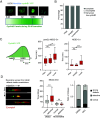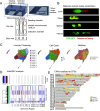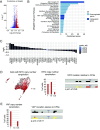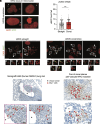Mechanical stress during confined migration causes aberrant mitoses and c-MYC amplification
- PMID: 38990945
- PMCID: PMC11260125
- DOI: 10.1073/pnas.2404551121
Mechanical stress during confined migration causes aberrant mitoses and c-MYC amplification
Abstract
Confined cell migration hampers genome integrity and activates the ATR and ATM mechano-transduction pathways. We investigated whether the mechanical stress generated by metastatic interstitial migration contributes to the enhanced chromosomal instability observed in metastatic tumor cells. We employed live cell imaging, micro-fluidic approaches, and scRNA-seq to follow the fate of tumor cells experiencing confined migration. We found that, despite functional ATR, ATM, and spindle assembly checkpoint (SAC) pathways, tumor cells dividing across constriction frequently exhibited altered spindle pole organization, chromosome mis-segregations, micronuclei formation, chromosome fragility, high gene copy number variation, and transcriptional de-regulation and up-regulation of c-MYC oncogenic transcriptional signature via c-MYC locus amplifications. In vivo tumor settings showed that malignant cells populating metastatic foci or infiltrating the interstitial stroma gave rise to cells expressing high levels of c-MYC. Altogether, our data suggest that mechanical stress during metastatic migration contributes to override the checkpoint controls and boosts genotoxic and oncogenic events. Our findings may explain why cancer aneuploidy often does not correlate with mutations in SAC genes and why c-MYC amplification is strongly linked to metastatic tumors.
Keywords: aneuploidy; chromosome segregation; mechanical stress; mitosis; mitotic spindle.
Conflict of interest statement
Competing interests statement:M.P. is of the board of Directors and stakeholder of CheckmAb s.r.l. and is a recipient of grants under a research agreement with Bristol-Myers Squibb and Macomics.
Figures





Similar articles
-
Oncogenic MYC amplifies mitotic perturbations.Open Biol. 2019 Aug 30;9(8):190136. doi: 10.1098/rsob.190136. Epub 2019 Aug 28. Open Biol. 2019. PMID: 31455158 Free PMC article.
-
MYC Dysregulates Mitosis, Revealing Cancer Vulnerabilities.Cell Rep. 2020 Mar 10;30(10):3368-3382.e7. doi: 10.1016/j.celrep.2020.02.041. Cell Rep. 2020. PMID: 32160543 Free PMC article.
-
c-MYC delays prometaphase by direct transactivation of MAD2 and BubR1: identification of mechanisms underlying c-MYC-induced DNA damage and chromosomal instability.Cell Cycle. 2007 Feb 1;6(3):339-52. doi: 10.4161/cc.6.3.3808. Epub 2007 Feb 3. Cell Cycle. 2007. PMID: 17297307
-
Crosstalk between oncogenic MYC and noncoding RNAs in cancer.Semin Cancer Biol. 2021 Oct;75:62-71. doi: 10.1016/j.semcancer.2020.10.014. Epub 2020 Nov 4. Semin Cancer Biol. 2021. PMID: 33160022 Review.
-
Deregulation of the centrosome cycle and the origin of chromosomal instability in cancer.Adv Exp Med Biol. 2005;570:393-421. doi: 10.1007/1-4020-3764-3_14. Adv Exp Med Biol. 2005. PMID: 18727509 Review.
Cited by
-
Compressive stresses in cancer: characterization and implications for tumour progression and treatment.Nat Rev Cancer. 2024 Nov;24(11):768-791. doi: 10.1038/s41568-024-00745-z. Epub 2024 Oct 10. Nat Rev Cancer. 2024. PMID: 39390249 Review.
-
Tissue mechanics in tumor heterogeneity and aggression.Trends Cancer. 2025 Aug;11(8):806-824. doi: 10.1016/j.trecan.2025.04.004. Epub 2025 Apr 29. Trends Cancer. 2025. PMID: 40307158 Review.
-
Video microscopy: an old story with a bright biological future.Biomed Eng Online. 2025 Apr 16;24(1):44. doi: 10.1186/s12938-025-01375-8. Biomed Eng Online. 2025. PMID: 40241123 Free PMC article. Review.
References
MeSH terms
Substances
Grants and funding
LinkOut - more resources
Full Text Sources
Research Materials
Miscellaneous

